How to DJ Drum and Bass?
DnB Tutorials and mixing techniques
Drum and Bass is one of my favourite musical genres partly because its such a joy to mix.
Its fast pace, thundering bass-line, melodic pads and intricate percussion make it a fantastic musical genre to DJ with.
So you want to mix Drum and Bass too right?
I’ve created the ultimate guide to mixing Drum and Bass. The best tips, DnB tutorials and techniques to improve your DJ skills.
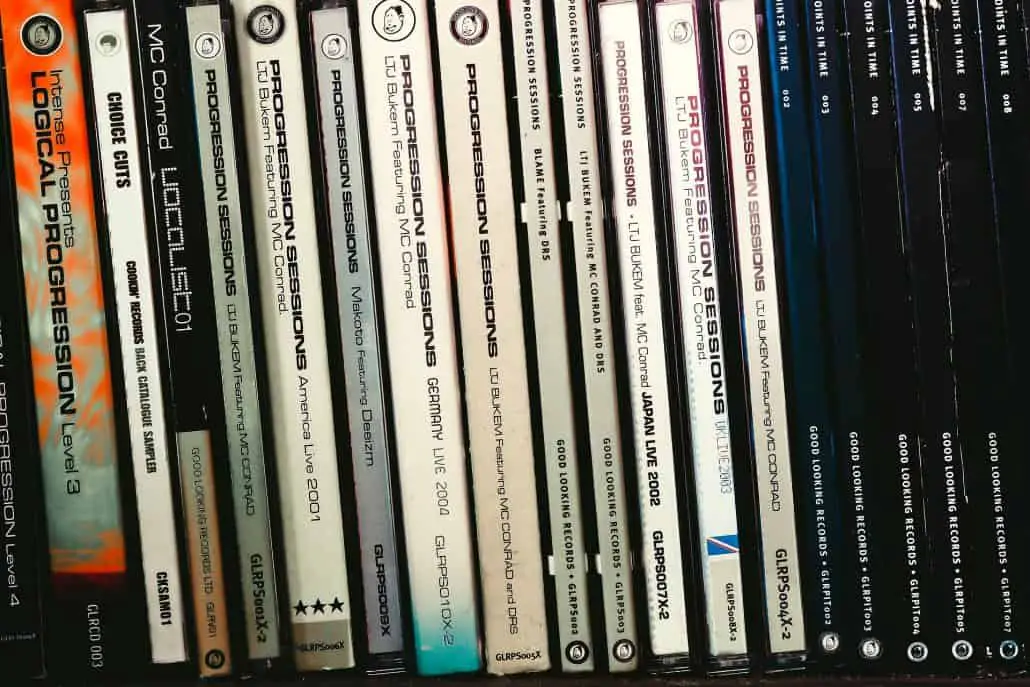
Almost every Drum and Bass tune can be broken down in to a number of layers. These layers help create the intense, melodic and rhythmic sounds of Drum and Bass.
Because they’re present in most tracks you can use some or all of them to create amazing mixes. Working seamlessly from one tune to another or chopping and changing between tracks to create your own unique DJing style.
The layers are:-
- Percussion
- Bassline
- Melodies / Stabs and Riffs
- Pads
- Vocals / Samples
Let’s go through each of these to see how you can mix them perfectly.
Percussion
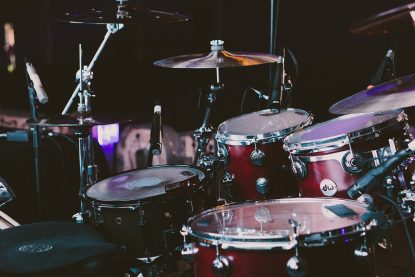 Drum and Bass would be nothing without the intricate percussion patterns. Running around 180 beats per minute, the percussive elements create a texture that is the bed of any Drum and Bass track.
Drum and Bass would be nothing without the intricate percussion patterns. Running around 180 beats per minute, the percussive elements create a texture that is the bed of any Drum and Bass track.
Its presence or absence is what creates the breaks and intense sounds while the off-beat kick drums are what give Drum and Bass its fast rhythmic feel.
So you can make good use of multiple elements of the percussion in your DJ mixes. Chopping and changing between two tracks quickly to create your own percussion patterns (more on that later).
The percussion can often help your mixes slip seamlessly between tunes if you pick just the right tracks to mix. It can also be the one element of your mix that messes everything up.
So understanding what percussions compliment each other and which ones jar is one of the most important parts of learning to DJ with Drum and Bass.
Here’s some good examples of drum and bass percussion
https://soundcloud.com/sampleism/dnb-4-the-headz-sample-pack-6
Bassline
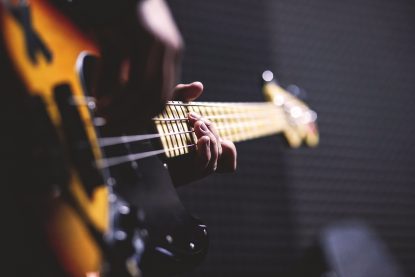 Who doesn’t love a fat bass-line in a Drum and Bass tune? It can be deep and sit in the background of a tune adding texture and depth or it can be in your face and intense, ruling the track like a freight train. Both can be excellent.
Who doesn’t love a fat bass-line in a Drum and Bass tune? It can be deep and sit in the background of a tune adding texture and depth or it can be in your face and intense, ruling the track like a freight train. Both can be excellent.
Basslines are not present through the entire track, in fact most Drum and Bass tunes don’t start with a bassline, giving you time to mix between tracks easily with no clashing bass to wreck your mix.
As a general rule bass-lines do not mix well together. They rarely compliment each other, its rare to find 2 that do. So I highly recommend that make sure the bassline of your new track doesn’t come in until the bassline from your old track has stopped.
Most full length Drum and Bass tracks are structured this way for this very reason.
Check out this track from Shy FX, one of the most memorable bass-lines of any Drum and Bass tune
Melodies
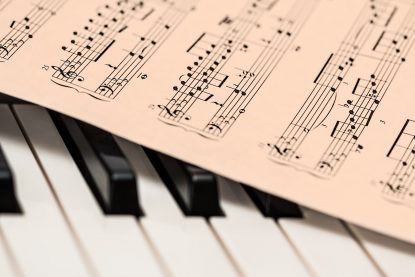 Now that you have your percussion and bassline your tune needs a new texture on top. This is where a multitude of instruments, synths, simple notes and punchy stabs come in to play.
Now that you have your percussion and bassline your tune needs a new texture on top. This is where a multitude of instruments, synths, simple notes and punchy stabs come in to play.
Depending on the sub-genre of Drum and Bass you’ll find melodies are used in very different ways but they nearly always stick to one chosen key.
This key can either compliment or really conflict with your next track so its important to understand what keys work together well and which don’t.
Most modern software driven controllers have key change options which sometimes sound good, sometimes sound awful.
Most tracks don’t start or end with a melody layers, usually returning back to just percussion, so when the melody is present you and your audience know the track has really kicked in. You can use this “marker” as the start or end point of a mix, as well as adding extra layers if the keys from your two tracks match. More on key matching later.
You’ll find some great examples of melodies on this sampler. Pianos, stabs, synths, bells and more.
Pads
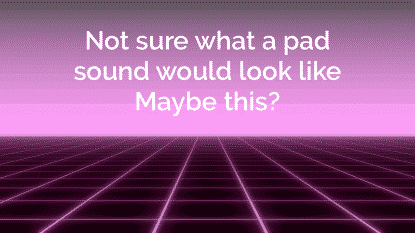 Not all Drum and Bass tunes have pads in them, usually found in the more melodic sub-genres.
Not all Drum and Bass tunes have pads in them, usually found in the more melodic sub-genres.
These add an extra beautiful layer of sound giving texture and emotion to a track.
These are often accompanied by melodies but can hang around longer, always in a complimenting key.
You’ll need to watch out for these as depending on the type of pad you’ll find some mix well, others don’t.
Here’s a great example of drum and bass pads
https://soundcloud.com/sampleism/dnb-4-the-headz-sample-pack-8
Vocals and Samples
 Vocals are becoming increasingly popular in Drum and Bass sub-genres, usually not entire verse and chorus arrangements but simple repeating vocals with delay echos and other soundbites thrown in to add a human layer to the tune.
Vocals are becoming increasingly popular in Drum and Bass sub-genres, usually not entire verse and chorus arrangements but simple repeating vocals with delay echos and other soundbites thrown in to add a human layer to the tune.
As you may already know, multiple vocals almost always clash, making both unrecognisable and annoying.
Its why most Drum and Bass tunes don’t start or end with vocals, allowing you to mix in and out without causing nasty drum and bass mixes.
Because you almost never mix when vocals are present, the key of the vocals isn’t important. Keeping one set of vocals far away from another track’s vocals means you’re free to swap keys, sub-genres and even mix during vocal breakdowns to add a new percussive layer and creative sound.
Here’s a Drum and Bass mix with plenty of vocals and samples.
Each layer of a Drum and Bass track offers a different DJ mixing opportunity. By far my favourite to play around with is the percussion.
Kick drums are often the same pattern between tracks giving you something lock two tunes together, but the percussive instruments and patterns are great fun to be creative with.
Unlike other dance music genres at lower or similar tempos, the layers mentioned above can be creatively mixed in, out, cut and chopped around. DJ-ing Drum and Bass is often all about the long expansive percussion and melody loops, giving you ample time to do some really special mix techniques.
So here’s a few to get you started. If you’ve ever listened to a Drum and Bass DJ mix you’ll recognise some of these.
The Seamless mix
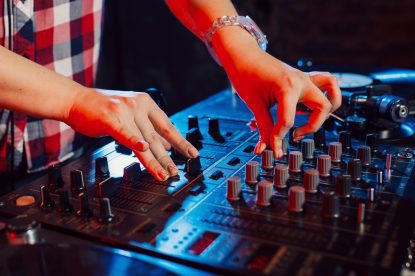 Let’s start with the one that sounds basic and simple but is actually often overlooked. This is because Drum and Bass tunes are often intense, in-your-face sounds which lend themselves to rougher cut mixes.
Let’s start with the one that sounds basic and simple but is actually often overlooked. This is because Drum and Bass tunes are often intense, in-your-face sounds which lend themselves to rougher cut mixes.
In fact some tracks really don’t want to be seamlessly mixed together with producers creating sounds that can jar if you’re trying to seamless mix.
Pick your tracks carefully, find 2 tunes that have long percussion intros and plenty of time before the bass-line or melody kicks in. If there’s some vocal samples thats fine as long as they don’t clash between the two tunes.
To practice the seamless mix you can also create 16 or 32 beat loops in your DJ software, giving you infinite time to understand how to truly seamless mix.
So lets get started…
Track 1 is playing, usually nearing the end of the track, with melodies and vocals disappearing, leaving just bass-lines and percussion, eventually just percussion. It’s during this deconstruction that your seamless mix will work best, as often Track 2 will be building up. If you can time the mix just right the two will work in harmony, handing over the baton from one to the other.
1. Get your tracks in sync
Start playing track 2, starting it on the 1st of 16 or 32 beats as the 4 x 4 nature of dance music is almost always structured in this manner.
Make sure your 2 tracks are perfectly beat matched, either manually (always a good skill!) or by using the sync feature. You’ll still need to check the software has perfectly beat matched as the off-beat kick drum nature of drum and bass can confuse some DJ software.
2. Reduce high and low frequency
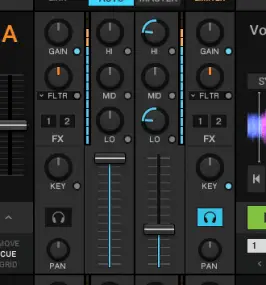 I recommend reducing the high and low frequencies on track 2 before you bring the volume up from zero. This helps reduce any punchy sounds or crisp high hats that could make it too obvious your mix has started.
I recommend reducing the high and low frequencies on track 2 before you bring the volume up from zero. This helps reduce any punchy sounds or crisp high hats that could make it too obvious your mix has started.
3. Increase the volume slowly
I mean really slowly, its Drum and Bass so there’s no major rush. You’ll notice you can just about hear the new percussion of track 2 layered over track 1. Your audience probably wont be so aware as they have no idea when the new track is coming in. This is what makes the seamless mix so effective.
Now slowly increase the volume up to 5o% or 60%, slowly increasing the high frequency volume back to its normal position. This will bring in the high hats which generally compliment each other more effectively than the lower kick sounds.
4. Reduce frequency volume on track 1
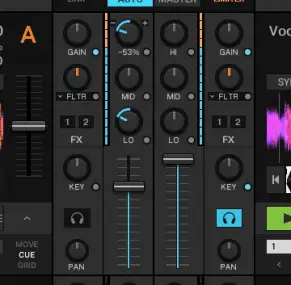 Its time to start reducing the kick on track 1 while also increasing track 2’s volume. This lets track 2’s lower frequency kick drums start to take over. As there’s plenty of kick from track 1 you don’t need to return the low frequency volume back to normal on track 2 just yet.
Its time to start reducing the kick on track 1 while also increasing track 2’s volume. This lets track 2’s lower frequency kick drums start to take over. As there’s plenty of kick from track 1 you don’t need to return the low frequency volume back to normal on track 2 just yet.
Over the length of your mix you’ll be adjusting multiple things. Bringing the volume fader of track 2 . up to 100% while reducing the volume on track 1 and reducing the low frequency.
Once you feel track 2 is more dominant and taking the lead in your sound you can reduce the high frequency volume on track 1 as well.
5. Keep it going
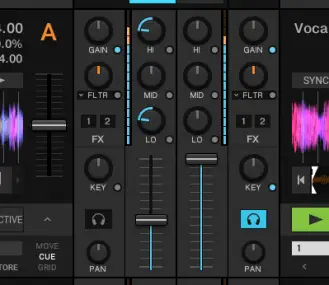 Keep track 1 playing in the background, even at just 50% volume for as long as you can. This keeps the texture of both tracks and makes it feel as though track 2 now contains track 1’s percussive elements.
Keep track 1 playing in the background, even at just 50% volume for as long as you can. This keeps the texture of both tracks and makes it feel as though track 2 now contains track 1’s percussive elements.
You can always loop track 1 when just the percussion is playing. By now track 2 will probably have bassline, melodies building up, some vocal samples, all adding layer upon layer. Such a beautiful sound!
Mixing over breaks
Drum and Bass nearly always contains intense moments of percussion and bass-line, with quieter more emotional moments of breakdowns where just vocal or melody samples are present. I love to mix over these breakdowns with a new percussive sound, or if the key is right add a new bass-line on top of it. Here’s how.
Use the visual guide on your software or the change in groove on your vinyl record to let you see where a breakdown might be. Its usually quite obvious as a there’s a clear change in rhythm and intensity.
Sync your tracks
You’ll need everything beat matched and ready to go before the breakdown happens. As there’s only one layer of percussion playing during the break its harder to keep things perfectly beat matched, practice makes perfect on this one!
When it the break occurs you have a few options. Either instantly start track 2 playing, with percussion layered over track 1’s break, or wait a certain number of beats.
Usually you have to wait 16 or 32 beats if the break is long enough, but you can bring it in sooner after 4 or 8 beats.

You can leave the high and low frequency volumes at 100% and your volume fader at 80-100% for track 2.
The important thing to remember is that a break is usually followed by a build up and a kick back in to full percussion and bass-lines. Something you will probably want to avoid.
Time it perfectly
So the idea is to get your mix done before the break ends. You can do this by looping the break giving you more time to mix, or by being aware how long you’ve got left and fading out or filtering out the break so that the track 2 takes over.
This works well if you know the melody or vocals of track 2 kick in just as track 1’s break was going to end.
Cut and Switch mixing for drum and Bass
This mix you have no doubt heard in Drum and Bass mixes before. It’s probably the most fun you can have with this dance music genre and there aren’t many genres that lend themselves to being chopped around so much.
Use the crossfader
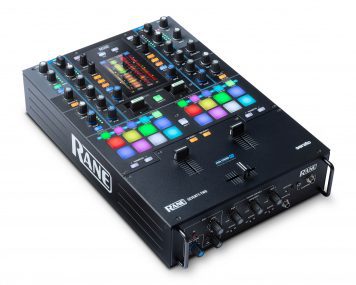 To cut and switch a Drum and Bass mix style you will most likely want to use your cross fader, most mixers have them.
To cut and switch a Drum and Bass mix style you will most likely want to use your cross fader, most mixers have them.
If yours doesn’t you’ll want to hold on to both the volume faders and be ready to bring one up and the other down quickly!
Have both your tracks beat matched (of course). It’s vitally important they are perfectly synced to make sure it sounds as though one track contains 2 percussion styles.
Works best over percussion loops
Cutting and switching works best when there’s just percussion but you can do it at other times too.
If there’s vocals, melodies or pads playing then remember you’re going to lose those sounds briefly which can sound jarring or it can really add to the mix! Experiment and see what works for the tunes you’ve selected.
If track 1 and track 2 are playing and on the same beat (i.e. first of 4 beats) then flick your cross fader quickly to track 2 and then back to track 1.
Play around with when you do this flick and how long you leave the fader at track 2.
Get creative!
You can do super short flicks catching just a few moments of percussion from track 2, or you can double flick catching certain parts of it.
If you’re feeling brave you can leave it on track 2 for a 2 or 3 beats, I usually do this just before I want to launch in to track 2 taking over the mix.
Its a great way to tease what tune is coming next, especially if you know the crowd will recognise it, teasing elements they may know.
Pick the right moments
One thing to remember is that once you start cutting and switching your 2 tracks, its usually not possible to do a seamless mix or mix over a break.
You can of course but I find it more fun to be a little rougher with the mix. Your audience have already been treated to some quick stabs of track 2 and will no doubt be cheering to hear more of it. So you can launch in to mixing to track 2 with a more intense approach.
If you’re doing this then make sure track 2 has the same volume level as track 1 and is ready to take over the melody and pads if there are any.
There’s no point mixing in track 2 if you’ve got another 60 seconds of just percussion. Get ready to really pass the baton with some intensity!
Conclusion
There are plenty of other mixing techniques you can try but these are my 3 favourite which are worth practicing over and over. Once you’ve nailed them you can really start to get super creative.
An extra bonus…
Check out this great video from DJ Vodicy showing an advanced mixing style. Mixing two breaks at the same time to hand over from one track to the other.
This only really works when the keys compliment each other or are the same. It’ll take some practice but is highly effective. Check it out
Drum and Bass, as you can probably tell by now, is all about the layers and soundscapes. It relies heavily on keeping a very structured approach, elements coming in and out after 16 or 32 beats. Plenty of repetition and identifying sounds that help to build up the larger picture.
It’s predominantly a loops and samples based dance music genre, perfect for DJ controllers that can help you quickly create loops for yourself.
This allows you to be creative and remix a track on-the-fly in front of your adoring audience. Adding whole new levels to your mixes!
If creating and controlling loops is difficult then its not going to be easy to be creative. So you’ll need a controller that has everything you need right there in front of you.
Roland DJ-505 DJ Controller
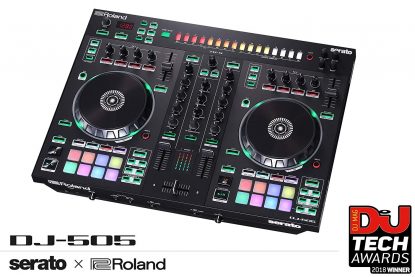 For super creative loops and drum patterns look no further than the legendary Roland Dj Controllers.
For super creative loops and drum patterns look no further than the legendary Roland Dj Controllers.
The 505 actually has drum machine loops built in so you can not only loop parts of the tracks you’re playing but add your own drum loops on top.
It works perfectly with Serato DJ, one of the industry standard DJ software apps.
With 2 decks right in front of you there’s no end to the creativity, all the buttons you need to quickly launch a loop, jump to a hot cue you’ve created in your tracks, resize a loop sample, add your own drum samples and quick cut and switch between drum and bass tracks, its all there for you.
No need to configure software to help you. This makes it well worth the price tag. Check out the latest prices of the Roland DJ-505 DJ controller here.
If you’re on a tighter budget then check out the DJ-202 controller as well which is less than half the price but still packs some great looping features.
Native Instruments Traktor Kontrol controllers
I personally am a huge Traktor fan and there is no better hardware manufacturer than Native Instruments for looping DJ controllers.
They create arguably the most intuitive DJ controllers available so if you’re looking to get creative with your Drum and Bass DJ techniques look no further. There’s a couple of great options I can definitely recommend.
Native Instruments Traktor Kontrol S2 Mk3
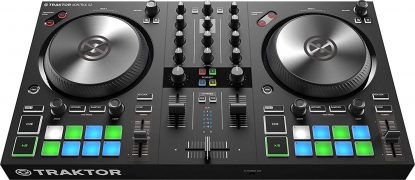 For those on a budget but still want a wealth of looping features right at your fingertips check out the S2 Mk3.
For those on a budget but still want a wealth of looping features right at your fingertips check out the S2 Mk3.
2 decks of precision DJ controls with the ability to jump to loops and cues, create new cues on the fly and seamlessly jump between multiple loops with Traktor’s powerful loop software. For the latest price and customer reviews check it out here.
Native Instruments Traktor Kontrol S8 DJ Controller
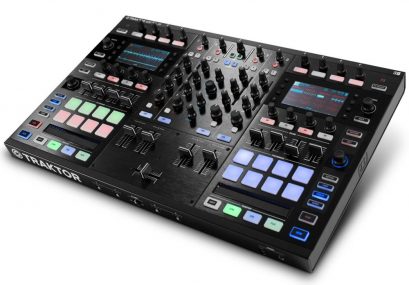 For the ultimate in creativity it simply doesn’t get better than the S8. You can apply effects to multiple loops playing at the same time.
For the ultimate in creativity it simply doesn’t get better than the S8. You can apply effects to multiple loops playing at the same time.
Modify and select loops with ease and get tracks in the “Stems” format which allow you to fade out layers of the track including percussion, melodies, vocals and pads!
It doesn’t get better than that. This is the controller I would most definitely opt for if you’re serious about DJ-ing Drum and Bass. For the latest price and user reviews go here.
For those on a tight budget
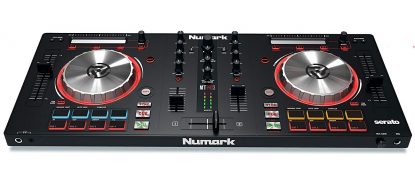 Take a look at the Numark Mixtrack Pro 3 which has some entry level looping controls and capabilities.
Take a look at the Numark Mixtrack Pro 3 which has some entry level looping controls and capabilities.
It’ll definitely get you started and is compatible with Serato DJ light so a great controller to get started with.
Keep in mind you may soon out-grow the creative limits of this controller so its always worth thinking about what your next step might be. For the latest prices go here.
As I’ve mentioned Drum and Bass DJing is all about the loops of percussion, melody and vocals. So you can really go to town and be creative by chopping up your favourite tunes and reworking them to suit your style. This takes some preparation on your part but is well worth it.
Add hot cues and loop markers
Firstly you need to load a tune in to a deck in your software, then skip forward to where you can visually see a change in the waveform pattern. You can of course listen to the track but if you’re pushed for time just jump ahead.
Use the software to precision mark with the hot cue or loop tool where there’s a change in the tune. Either bassline, melody or vocals coming in.
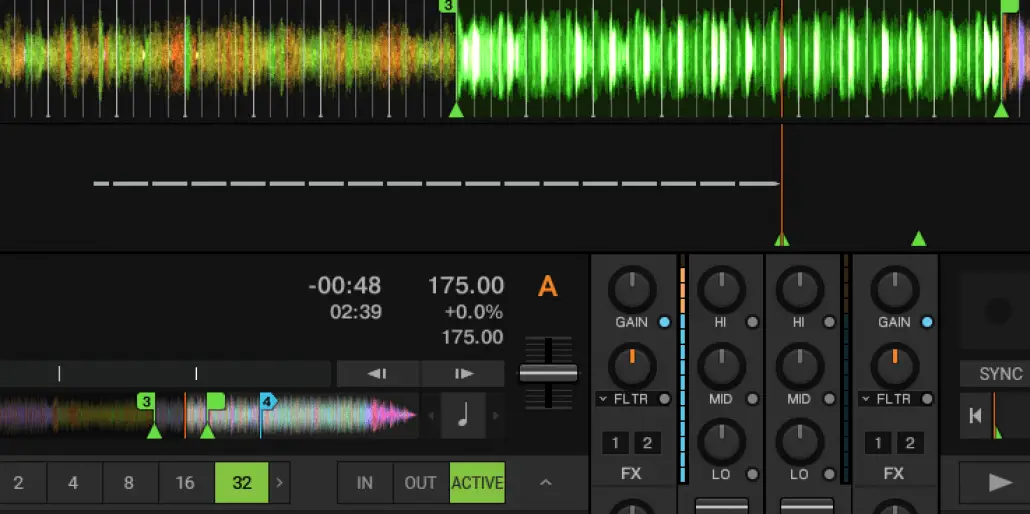
I recommend creating at least one loop cue that is just percussion, you’ll use this more than any other loop.
You could create a loop cue just for a short vocal sample that you could add effects to when mixing over other tracks. This can sound great with filters, reverb and delay echos added.
For just hot cues I recommend having one when the bassline starts, one at the start of a breakdown and one towards the end where the tune returns to just percussion. The last could also be a loop as this comes in handy for long extended seamless mixes.
Be sure to do this for every track in your library so that when you’re ready to mix you’ve got the hot cues and loops at your finger tips. With the right controller you can jump instantly to these and then jump back again, restructuring the track to suit your mix.
Now that you’ve prepared all your Drum and Bass tunes for the ultimate DJ set you can even more creative with effects built in to your DJ software.
 Traktor especially does a great job of this with multiple effect layering possible.
Traktor especially does a great job of this with multiple effect layering possible.
Some effects work better than others so here’s a handy list of those I recommend trying.
- Beatmasher
- Delay
- Filter
- Flanger
- Reverb
- Noise
There are many more but these are the effects I go back to time and time again. With Traktor you can even group effects to create one new effect thats easy to control. I recommend taking a look at this page all about Traktor 3’s effect capabilities.
I highly recommend you watch this video to see loops, cues and effects in action.
[/heading]
More great DJ advice
I hope you found this article about DJing Drum and Bass useful. Here’s some more articles I think would really help you take your DJing to the next level.
